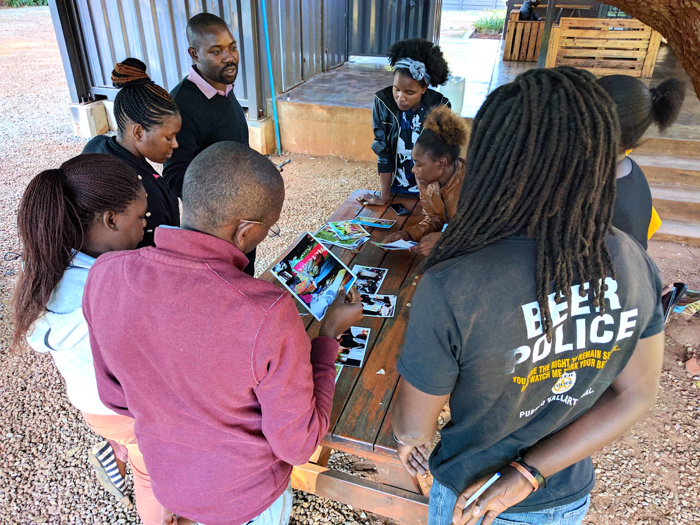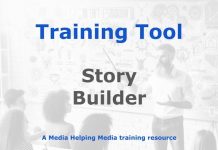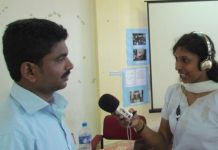
This article was written for a group of young citizen reporters from remote rural communities in Zimbabwe who were learning how to become journalists.
The course, held in Harare, taught a group of enthusiastic newsgatherers from the Mobile Community Zimbabwe (MCZ) the skills needed to record, edit and broadcast stories about their neighbourhoods using their mobile phones. The week-long programme included teaching editorial ethics in order to help the reporters to produce accurate, factual, and impartial news reports about the issues that mattered most in their neighbourhoods.
The beauty of citizen reporting is that it can be fast and fresh, down-to-earth and uncomplicated, and, sometimes, reach areas not always covered by mainstream media.
It’s about reporting on something that people are concerned about, and presenting what they say in a way that those involved in the story can relate to.
It’s not meant to be complicated or to looking stunningly professional. It’s not meant to try to copy professional media.
It often involves producing a report on a topic that, had it not been for the person recording events with their mobile phone, the story would never have been told.
And, free from many of the technical obstacles that might otherwise hold back others, citizen reporters can sometimes offer a perspective lacking elsewhere.
That’s all good. It offers another take on life. A view that is often hyperlocal, put together by enthusiasts, journalism students, activists or amateurs, and carrying the authenticity of the learning curve.
However, if we are to take our citizen reporting to the next level, and, instead of just covering stories as we find them, attempt to inform the public debate, we need to weave in elements of journalistic best practice.
We need to move from citizen reporting to citizen journalism.
Citizen reporting – the basic version
Typically, this is how citizen reporting plays out.
You’ve either stumbled across an important story, or you have been alerted to something happening. You might see an everyday event that you feel needs to be covered.
Perhaps the issue is unofficial roadblocks in Zimbabwe, where young people are preventing motorists from using urban back roads to avoid police checkpoints. The youths are demanding money from drivers.
It could be widows living in a remote village who are working together to make and sell jam in order to help their community survive.
Both are important stories.
Now, you could just set off, take a few shots, talk to a couple of people and edit together a short piece of, say, 1’30” to 2’00” that shows what is happening.
That would be fine. People might like to see the roadblocks and hear from the people involved. They might like to watch the fruit being picked and the jam being made. Nothing wrong with that.
They are interesting stories, they are local, they might have been missed by mainstream media, and people might be interested in viewing them.
And when the stories are shared on social media, people will probably click on them and share them with their own social network.
But the question is, could you have done more?
Did you ask the right questions? Did you dig around a bit to try to expand on what you saw?
Most importantly, will your reporting make a difference? Does it matter?
The challenge is to produce a piece of meaningful journalism that informs the public debate.
Producing citizen journalism that matters
It’s all down to planning. Let’s start with the editorial content.
Before you set off, spend some time thinking through what you might need in order to explore all the angles of the story.
If you have a colleague or friend you can talk to, bounce some ideas around with them.
You should be hoping to find answers to the six essential questions all reporters should be ready to ask. Those questions are what, why, when, how, where and who.
Below are a few ways these simple questions could help uncover information that might not otherwise surface from an ordinary interview.
- What: What is cause? What is the impact? What is the cost?
- Why: Why is it happening? Why does it matter? Why are people concerned?
- When: When did it happen? When will it be fixed? When will we know?
- How: How did it happen? How long will it take? How much did/will it cost?
- Where: Where did it happen? Where is the evidence? Where are those responsible?
- Who: Who is involved? Who is doing something about it? Who is affected?
You will probably think up many different variations on these six questions. But just considering these questions will ensure you are far better prepared than if you simply head off to the scene, smartphone in hand, trying to find someone who is willing to talk to you.
And asking just some of these six questions will also mean that when you return to edit your piece, you will have more interesting material to work with. You might also uncover a valuable news angle so that you can revisit the story in the future.
There is nothing worse than returning from covering a story and realising you forgot to ask a crucial question.
Ensuring your citizen reporting looks good
Once you have planned your piece, you need to give some thought to the technical requirements.
What shots will you need? How will your piece start? This is often called the ‘establishing shot’ – which is the first few frames that introduce your audience to the story.
You will need to think about what ‘cutaway shots’ you might need. These are the short clips of detail that you might want to use to emphasis a point, cover an edit, or simply break up a longer shot.
And what shots might you need to end the piece? What image will work best with your final sentence?
Think all these things through before you go – or as you travel to the scene – and you will save yourself so much grief when you come to edit the piece later.
Give some thought to what sound effects might you need. It’s always good to shoot some background noise – ambient sound (sometimes called wild track) that can be used to help bridge edits when you return to your desk.
And gather enough material. Far better to have too many opening shots, details shots, close up shots and spare ambient sounds than not have enough.
Now we have content that is editorially and technically strong, we can start to piece together our report. This is where the citizen reporter starts to become a citizen journalist. See Interviewing for video journalists.
Adding context is essential
This next step is adding context. Context often answers the “So What?” question.
Numbers, data, statistics, history, geography and time are all valuable elements for adding context.
For example, let’s take the story of a fatal traffic accident on the road between Gweru and Bulawayo. A coach crashes. Many are killed and others are injured.
To put this story in context we need two of the elements listed above; numbers and history. Statistics would be good, too, but they might be hard to obtain.
Let’s keep it simple and start with the first two.
We need to find out how many are dead or injured. We also need to try to find out whether this is the worst accident of its kind, or whether it’s a common occurrence.
We need to find out how many such accident happen each year. Is this the worst year on record?
Numbers give us context. Without context the story lacks depth. Without depth we are not fully informing the public debate.
We can still do the story without the context. That’s fine. That is straightforward citizen reporting.
Publishing such a story is of value, and you might want to publish the raw version in the first instance to cover the breaking news story of the traffic accident. If so, go ahead, get a version out. Share it on social media. Let people know what is happening.
That’s a fine example of citizen reporting. However, a citizen journalist would want to develop the story. In mainstream media terms, they would now be covering the developing story.
Citizen journalists need to think through the story development angles.
Jot down a rough story plan
Before you set off, try to piece together a rough story plan.
Write down what you think the top line might be. Set out the questions you might want to ask. Think of the numbers you will need in order to add essential context, such as: How many? How much? How often? How long?
Consider where will you find two independent sources to help verify the story.
Imagine what you will need when you return in order to edit the piece.
List all the elements you will require. Far better to think these things through now, before you get to the scene, than kick yourself later for missing them.
You need to think of as many story angles and hooks as possible.
Write down all the possible related follow up stories that might be needed to fully explain what has happened. If you have time, research the background to the story.
Search online, post questions on social media, try to gather as much information as possible, preferably before, but also after, you shoot the material.
A well-researched piece will be more likely to inform the audience than a first-impression piece. See How to create a structured news report.
Is the journalism you are producing ethical?
Next you need to check whether your work is ethically sound. Have a look at Why editorial ethics are important and read through some of the training articles on that page.
Here are some of the main points to keep in mind.
- Is your story accurate and fair?
- Have you got your facts right?
- What about names? Have you got the right spelling? You may have to add text to your video to introduce the person. Ensure you get them to spell out their name and their title.
- Have you inflated or promoted any information or angles to try to make things sound more or less dramatic than they really are? You must never dramatise information to try to sell the story to your audience.
Is your story impartial and objective?
Did you manage to leave your own emotions at home, or did you take them with you when you shot the piece? Are you telling the story as it is, or are you pushing one particular line because you feel strongly about it?
You might feel passionate about an issue, but you must always rise above what you think in order to present the reality of the situation as it is. Doing so enables those who view your piece to make their own assessment of what is happening without being influenced by your particular take on things.
Have you tried to include different voices to reflect as many sides of the issue as possible? Have you treated people equally? Could you be accused of favouring one side in the story?
See our article on objectivity and impartiality.
What about privacy and consent?
Do those you are talking to know how the material might be used? Do they realise it will be shared on social media and, hopefully, go global?
Could your filming be an invasion of their privacy? Are they okay with that?
What about the vulnerable? Are you thinking of interviewing minors or people with learning difficulties? Have you got consent from their carers?
You may not need that consent if you are carrying out random interviews in the street – sometimes called vox pops – but you should seek it if you are talking one-to-one with someone who could be described as being vulnerable and who may not understand the consequences of what they are saying.
See our article on privacy and consent.
Taste and decency matters, too
Also, keep in mind that the pictures you are shooting, and the audio you are recording, will be seen by people of all ages.
Consider whether any images are too graphic. Could they upset, offend and disturb some in your audience?
Are there other ways you can shoot footage to tell the story without being too graphic?
Have you included some images that disturbed you when filming them? Is there anything gratuitous about your piece?
Always err on the side of caution. If you feel uneasy then your audience will probably feel uncomfortable, too.
And finally, uphold your integrity
- Is what you have produced a true and fair reflection of what you witnessed?
- Is it free from your own emotions and opinions?
- Have you been honest with those you interviewed, your audience, and yourself?
- Can you stand by what you intend to publish?
- Can you return to the scene, look people in the face and justify your actions?
If the answer to any of the above is ‘no’, then take a fresh look at your script, the clips you have chosen, the top line you selected, and the conclusion you have reached.
And be prepared to rework the whole package to ensure it really is a piece of informative journalism, rather than another item that adds to the the noise and confusion surrounding the issue you planned to cover.
See integrity for journalists.
Packing your bags before you go
On the practical level, there are some basics that you need to consider before heading off to shoot a story. Here are 10 considerations. You will probably be able to jot down more.
- Is your phone fully charged, and have you packed your charger?
- Have you got enough credit on your phone?
- Does someone know where you are going?
- Check latest news reports to see if the situation has escalated.
- Have you assessed all the dangers?
- Are you about to take any risks?
- Could anyone object to you filming and want to stop you?
- Have you enough cash with you?
- Are you dressed appropriately (you don’t want to stand out)?
- What might be a follow-up angle to the story?
What to do when you get to the scene
Look around, absorb, sense the mood, watch what people are doing before they realise you are covering the story.
Take lots of wild track – if nothing else, it will come in useful if you need to edit sound effects under some of your shots when you are putting the piece together.
Identify those you want to interview, talk to them, win their trust, explain who you are and how the material will be used – including how you plan to share the story on social media.
Check the background lighting and the background sound. If needed, ask the interviewee to move slightly so that the material you shoot is good enough to use.
If it’s windy consider putting a piece of sticking plaster over the microphone on your smartphone to reduce the wind noise.
Be ready to deal with knock backs
A common issue facing citizen journalists is that people sometimes refuse to talk, especially officials.
You might approach a police officer, ambulance worker, or fire officer and ask for details about an incident.
They might ask for accreditation: “Who are you and who do you work for,” they might say.
You might not be accredited. You might be a freelance working for yourself. As a result, they might refuse to talk to you.
The same is true with government officials. They might ask you to submit your questions in writing to their office and tell you that they will get back to you.
That’s just tough.
You probably won’t be able to change that attitude, so don’t bother wasting your time trying.
Instead, use your ingenuity and news sense to seek out other voices that will help you substantiate your story.
All you need to worry about is finding two independent sources to verify the information you are about to publish.
Those sources don’t need to be senior officials, they don’t need to be people in authority. It would be nice if you could talk to someone in those positions, but other voices will work.
Keep asking around, talk to more people, seek out disparate voices that can offer diverse perspectives.
Continue until you have those two sources.
At that point, you are ready to edit your piece of unique, in-depth, citizen journalism. And, if you have reached that point, well done.








